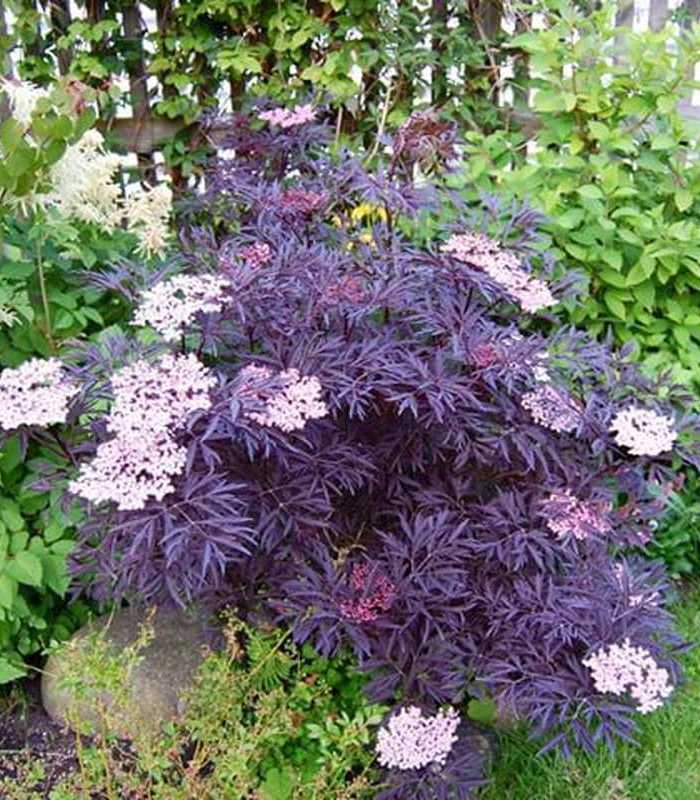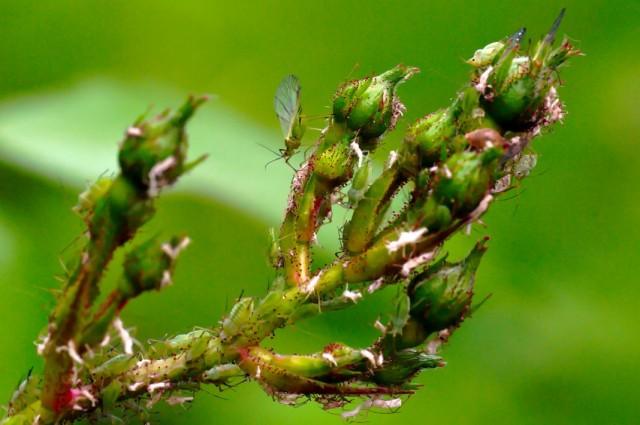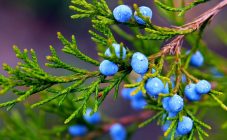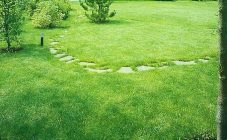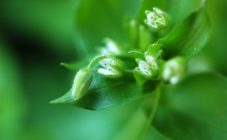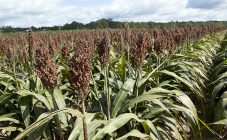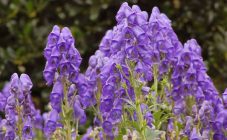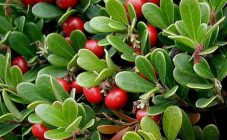Content:
Black elderberry is one of the most common crops. In the wild, it grows practically throughout Europe, including Eastern (Ukraine, Belarus, Moldova), in the Caucasus, North Africa, Asia (for example, Turkey and Iran) and even in New Zealand, however, this plant was brought there. ... Its medicinal properties have been known since ancient times; among some peoples, it was even considered a sacred plant. Black elderberry belongs to the Honeysuckle family, genus Sambucus. This name comes from the word "sambuce", which means "red paint" in Latin. Indeed, in the old days, elderberries were used to dye silk. The berries of the plant are used for food, they also have pharmaceutical value.
Description of culture
Black elderberry is a shrub that grows well in height (can reach 2-6 m). Some varieties look like trees and can grow up to 10 m in height. The young branches of the plant are green, over time they become brownish-gray. The leaves reach a length of 20-30 cm. Their bases are wide, but the edges are sharp. The upper surface of the leaf is dark green, while the lower is lighter.
A description of the plant would be incomplete without information on flowering. Moreover, some varieties are cultivated only for the sake of this in connection with their decorative properties. Elderberry blooms in May-June with small yellowish-white flowers that gather in large corymbose inflorescences. The flowering bush looks very beautiful. If the flower itself reaches only 5-8 mm in diameter, then the inflorescences can be 10-25 cm in size, and these shields rise above the crown of the elder for several weeks. Berries appear in August-September. From a botanical point of view, the fruits are shiny, juicy black drupes, although, in fact, their flesh is dark red. Their size is relatively small. The fruits of the black elderberry are edible and even useful, which is how they differ from other plant species, because in the same herbaceous elderberry they are poisonous.
The ripening time of elderberry depends on the area in which it grows. The Moscow region is one thing, and Siberia or the Urals is quite another. Elderberry is a heat-loving plant that is sensitive to lack of sunlight. In northern regions, shrubs may not have enough summer for the berries to fully ripen. Sometimes the fruits turn black only by November, when the leaves are already turning yellow.
Elderberry varieties
Successful elderberry cultivation begins with the correct selection of varieties. And this choice is influenced by many factors, including the planned region of growth. For example, in the Moscow region such varieties as:
- elderberry aurea. It is bred for decorative purposes, since it has an unusual leaf color - they can be golden and bright lime. Another beautiful yellow-leaved cultivar is the elderberry Aureo-variegata. Its bushes attract attention with their variegated leaves. An important characteristic of the variety is its unpretentiousness, resistance to adverse weather conditions. So this type of elderberry can be grown in the Urals;
- The Bimble elderberry is another decorative variegated variety. Its color is difficult to describe, but the bright yellow spots on its foliage attract attention.
- Elderberry Cuino Purple is an openwork variety. Its leaves change color during the year.In the spring they are bright green, and in the summer they turn purple, so that the bush will look elegant throughout the season,
- elderberry Black Lace. This variety is widely used for decorative purposes. The bushes look really unusual - the inflorescences of a pink shade stand out against the background of the foliage of an ink or lilac color. They have a lemon aroma, and the fruits of this variety are also valued for their taste characteristics.
There are other varieties, and mainly foreign selection. Most of them are bred in Austria and Holland. For example, this is a vigorous variety of Khashberg with elongated leaves and large inflorescences. It is a high-yielding variety with long-lasting berries. The Hamberg variety is famous for its aromatic fruits. And the elder Sambu has large fruits and a strong, but pleasant smell.
Reproduction
For all of the listed elderberry species, there are a number of general rules related to their cultivation. Reproduction is carried out by seeds, layering or woody cuttings. The latter option is the most common. Seeds are sown in autumn or spring, preliminarily carried out 50-day stratification. Crop maintenance is relatively simple - weeding, loosening and thinning are needed. Annual seedlings can already be planted in a permanent place. The stalk is rooted either in spring or at the end of summer. Depending on the climatic conditions, this is done either in the open field or in a greenhouse. For example, the Moscow Garden assumes the first option.
This plant loves warmth and sunlight, but in principle it can be considered shade-tolerant. It also tolerates dry air well. But black elderberry is characterized by less winter hardiness than red elderberry.
The plant is not so demanding on the composition of the soil, and the planting of these bushes is possible in areas with moist and fertile loams.
Before planting, the soil is prepared as follows - in about a month, compost or manure is introduced into the soil at the rate of 8-10 kg per 1 square meter of land, as well as 30-40 g of potassium salt and 50-80 g of superphosphate for the same area. Pits for it are made about 50 cm deep and wide, it all depends on what size the seedling will be. The distance between the holes should be 1.5-2 m, since the bushes can grow strongly. After planting, the aerial part of the bush is cut off to 20-30 cm. After that, the plant is watered and mulched with peat to prevent too active evaporation of moisture.
In the spring, the elderberry needs to be protected from sunburn, since the bark gets very hot during the day, and it can get colder at night. Therefore, the trunk and the forks of the skeletal branches are covered with lime. If damage is found on the bark, they are treated with a solution of potassium permanganate. Thanks to this, the bush will grow well. Pruning of the plant is carried out in the spring.
When the elderberry ripens in August, the berries must be picked immediately. And then the plant begins to prepare for wintering. In rainy weather, shoots can grow again - their tops need to be pinched. After harvesting, the branches are sanitized. At the end of September, fertilizers are applied and the soil is dug up in the trunk circle.
Properties of culture. How is the plant useful?
It is necessary to grow elderberry not only for the sake of decorative properties. All parts of the black elderberry contain useful substances.So, the fruits contain ascorbic acid, tannins, carotene, anthocyanins, which give them color and have anti-inflammatory properties. The flowers contain organic acids (including valerian), flavonoids, vitamin C, natural antiseptics. The bark contains essential oil, phytosterol and choline.
Pharmacognosy, the science that studies plant-based medicines, considers elderberry a valuable raw material. It has the following properties:
- all parts of the plant are characterized by a diuretic effect;
- bark, fruits, leaves and flowers have an anti-inflammatory effect;
- infusion of flowers is able to normalize the function of the adrenal glands;
- the fruits have a laxative effect.
Infusion of flowers can be used to treat burns, diaper rash, including in infants. It is used both for gout and in the treatment of coughs of bacterial or viral origin.
However, elderberry also has contraindications. For example, any medicinal products based on it should not be taken orally for chronic colitis and diabetes insipidus (due to their diuretic properties).
Diseases and pests
Elderberry is a plant resistant to pests and diseases. Sometimes aphids can infect the tops of the bush, and spider mites are even less common. To prevent this situation, in the spring the shrub is treated with a solution of Nitrafen (it is prepared exactly according to the instructions) or Bordeaux liquid. If the aphid has already appeared, then it is very difficult to deal with it, therefore prevention is so important. To get rid of this pest, soap solutions, herbal infusions (for example, onion or garlic) and birch tar-based products are recommended, but they are used only if the berries have already been harvested.
Useful information about the plant
The use of elderberries for decorative purposes is a trend in recent years. Previously, it was grown mainly for purely practical purposes. Gardeners were interested not only in its therapeutic effect. It has long been noted that this plant repels rodents and insects (for example, flies and cockroaches). Therefore, elder bushes were planted specifically closer to barns, and brooms of their elder branches were kept in houses.
Some cooks suggest using dried ripe berries in the preparation of lightly salted cucumbers. But the young inflorescences of the plant are added to the grape must - this will improve the taste and aroma of the wine in the future. Also, the inflorescences are added to the cookie dough. They are also used as a seasoning for first courses.
So, by planting black elderberry bushes on the site, the gardener gets not just a beautiful, but also a very useful plant that does not require labor-intensive care, but will delight with spectacular leaves and tasty fruits.

